Minimalist bedroom designs bring calm and peace into your life by clearing the clutter. Think of a room where everything is only used for one or a few things, the colours are muted, and the overall ambience is chill. Less is more with minimalist design, so every decision matters. Here is how you can transform your bedroom into a soothing sanctuary with minimalism:
Why Choose Minimalism?
It goes beyond simplicity to minimalism. It is about focusing on the few things that matter. Having a minimalist bedroom can help you remove the distractions in life, unwind, and wake up refreshed.
Someone needs to hear this: the whole art of living well is about quality over quantity, about condensing your space with that which is as functional as it is liberating. You are not setting up a room but establishing a haven; minimalist design clarifies that.
Tips to Create a Peaceful Retreat Minimalist Bedroom Designs:
Here are ten tips to create a peaceful retreat minimalist bedroom designs:
1: Selecting a Color Palette
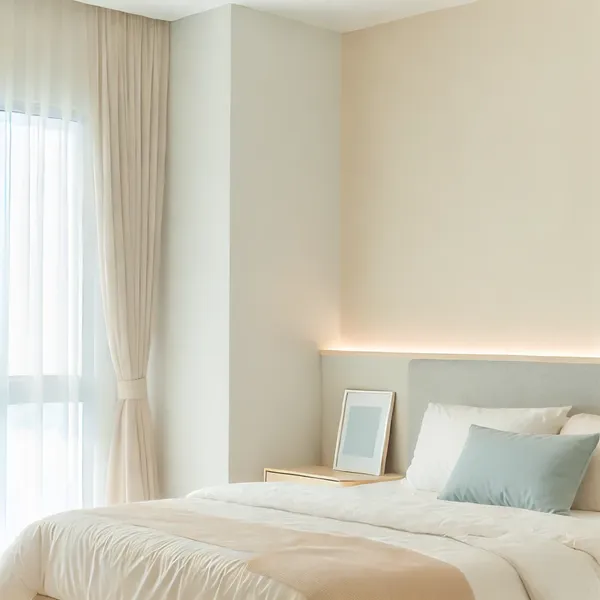
Minimalistic design is all about -> Colour. In fact, with the right colours, your room can appear airy, open, calm and relaxed.
- Go with the Neutrals: White, beige and light grey are all the rage right now for a good reason: they provide a calm backdrop.
- Incorporate Subtle Accents: A pale blue or soft sage green touch adds warmth without dominating.
- Restrict the Color Palette: You need up to colours for balance.
So try to get some samples of the colours you like and test them to see how they look in different lighting. Natural light can change the hue to be warm and welcoming or stark and frigid. Always check your palettes in the light of morning and evening.
2. Selecting the Right Furniture
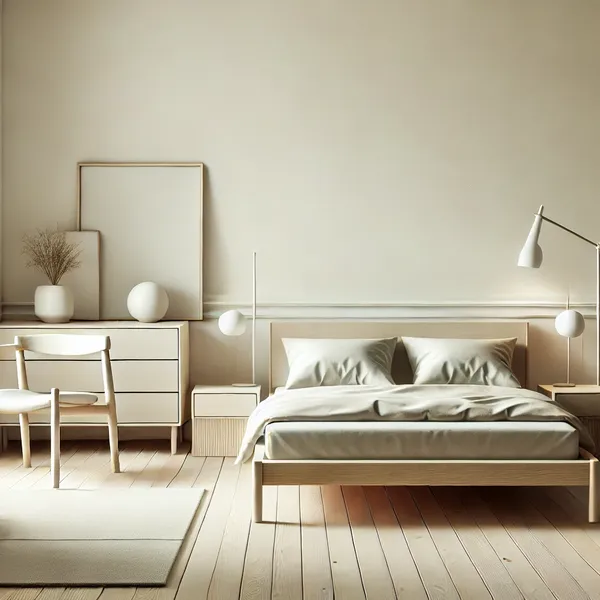
When it comes to furniture in a minimal bedroom, it should be simple and functional. Steer clear of excessive or tacky items.
- Low-Profile Beds: These beds have a lower profile (also known as more distance from the ground) and typically take up less visual space in a smaller room, making it feel larger.
- Dual-Purpose Items: When designing a space that serves multiple functions, the best options are those that already accomplish this (e.g., a bench with storage, a nightstand with drawers, etc.).
- Say no to clumpy bedside tables — just a lamp, book, or plant.
Furniture Checklist:
- A bed (best case platform or low profile)
- Two functional nightstands
- Dresser: storage bench or minimal dresser
- A chair for reading, but it is not necessary; a stool would also suffice
3. Embracing Natural Light
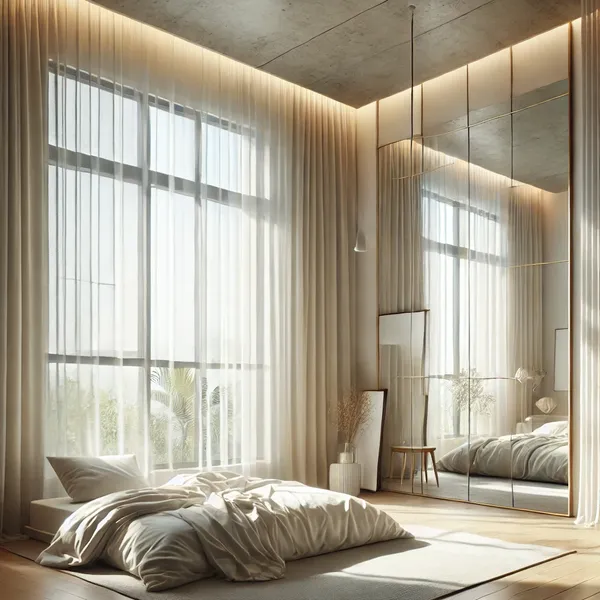
Minimalist design flourishes when bathed in natural light. The more light, the better! It increases the simplicity and lightness of your room.
- Go For Sheer Drapes: You can skip the heavy drapes and settle for lighter alternatives that let the sun leak in.
- Introduce Mirrors Well: A mirror positioned well to bounce natural light will amplify the sense of space.
- Avoid Accessory Window Dressing: less clutter on your Windows means a Cleaner look.
- Lighting: During the day, take advantage of natural light as much as you can, and especially in the evening, try to use soft and warm lighting. Just use bedside lamps or something simple for all-room lamps.
4. Making Wall Art and Decor Easy
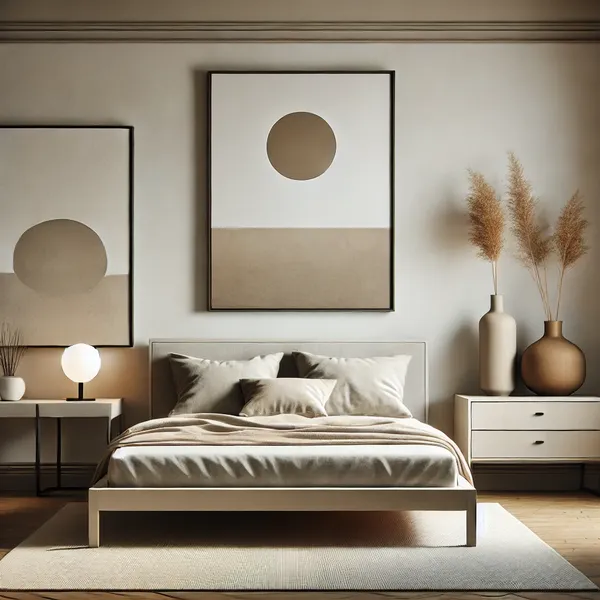
An empty room is not a minimal room — it is a room devoid of purpose. Add each item with the only underlying rationale.
- Limit Yourself to One or Two Artworks: One big frame on the bed or a couple of small, matching prints.
- Simplify your Decor: Small things work like a charm, such as a little vase or a sculpture.
- Image choices: scenic stuff, abstract stuff, or monochrome art blends well with a minimalist room.
Quick Decor Guide:
- Large artwork above the bed
- Simple, symbolic decorations on the dresser
- A textured sombre palette with simple, earthy components like stones or sticks
5. Keeping the Bed Linen Simple
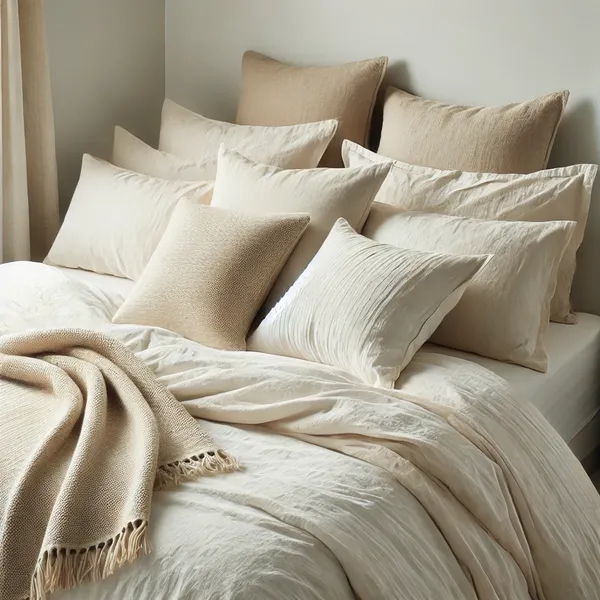
As the centerpiece of your room, it should be low-key and free of clutter. Opt for bed linen in a calmer palette of soft, muted tones.
- Opt for Natural Materials: Natural fibres like cotton, linen, or bamboo are soft, breathing-friendly and warm.
- Use Solids: Stick with bedding in white or beige and avoid prints
- Texture as a Layer: Use a wool throw blanket or textured decorative pillows instead of patterned prints for visual variety.
Bedding Essentials:
- Soft, neutral sheets
- Cozy blanket or throw
- Max: two or three pillows (no decorative pillows!)
6. Organizing Closet and Storage Space
Minimalism is when you only use elements you need. It also helps to maintain the peace in your room by decluttering your closet.
- Declutter Your Wardrobe: Less Clothes, less mess. Concentrate on pieces that you wear and genuinely enjoy.
- Employ Easy Storage Solutions: Baskets, drawer folder pieces, and clean storage containers assist you with keeping all of your needs neat.
- New Hidden Daily Clutter: Keep everyday items like shoes, bags, and laundry hidden behind closed doors or in storage.
Storage Ideas:
- Blanket Baskets or similar for small items
- Drawer Dividers (for organization)
- Wall storage for a minimalist look
- Plants: it is time to bring nature into your home
7. Bringing Nature Indoors with Plants
- Pick Low-Maintenance Plants: Indoor plants like snakes, succulents, or pothos best grow with less watering and care.
- Stick to just one or two plants: one single plant on a nightstand or dresser is enough.
- Do Not Use Trendy Pots: Do not buy trendy, expensive pots. Instead, use clay or simple ceramic pots.
Plant Choices:
- Snake plant (low maintenance indoor plant and purifies air)
- Peace lily (adds a touch of elegance)
- Tiny succulent (great for a side table in your bedroom)
8. Keeping the Floor Clear
Without so many items lying on the floor, the illusion of a bigger room and more space is created.
- Keep The Rugs Minimal: One neutral area rug under the bed can bring warmth without going overboard.
- Avoid Excess Furniture: Only have what is necessary, like your bed and dresser.
- Hide Your Shoes Away: Inside a closet or on a reasonably simple shoe rack, out of view.
9. Incorporating Soft Sounds and Scents
Having a room that can feel peaceful is about more than how it looks. Consider the smell and sound, as well.
- Try Using an Essential Oil or Candle: Lavender, eucalyptus, and vanilla are good.
- SOUNDS: If you can, try a small sound machine that can play gentle sounds, such as rainfall, ocean waves, etc., and provide a calm ambience.
- No Strong Scents or Noises: Keep it subtle and peaceful.
Sensory Additions:
- Essential oil diffuser
- White noise generator pocket sound machine
- Soft, unscented candles
10. Maintaining the Space
They are low maintenance since they have less furniture and knickknacks in a minimalist bedroom. It takes only a couple of minutes to keep everything clean.
- Quick Clean-Up Every Day: Make your bed, put your clothes back in their place, and tidy up before you head out for the day.
- Monthly Declutter: Every month, you should be going through items to see if you have anything for the trash bin or donation.
- No New Items: Only bring something new if you have to.
Frequently Asked Questions (FAQs)
Common Questions About Minimalist Bedroom Designs
Q: Does a minimalist bedroom mean I am buying all new furniture?
A: Not at all! You can use what you already own. Just only have things that have a function.
Q: Can minimalist bedrooms fit into small spaces?
A: Yes! Minimalism makes small rooms bigger; this style is clutter-free and bright.
In Conclusion, A minimalist bedroom design is not an empty room but a room full of intent. When you take a quality-over-quantity approach and select items that speak to you, your bedroom becomes more than just a bedroom. It becomes a refuge waiting for you every single day.
You might think of minimalism as freakishly boring. However, it can also be warm, cozy, and personal. Using your choice of colour scheme, furniture, and home decor, you can make it a sanctuary that feels like yours. Just change one thing at a time and see how your space becomes a calm, tidy oasis.
Make it your own, something you want to visit every morning. Happy designing!